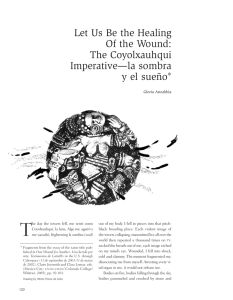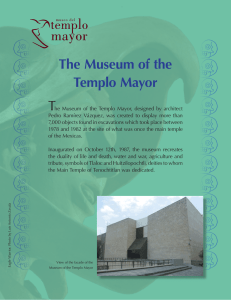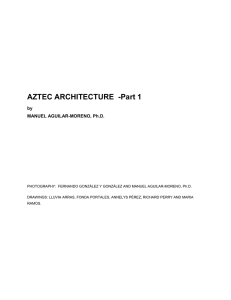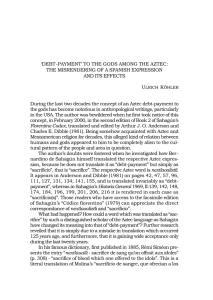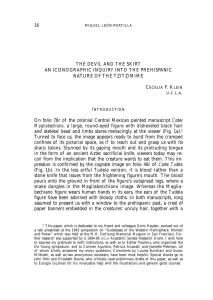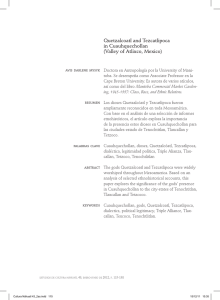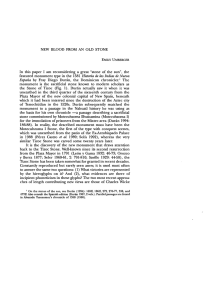Great Goddesses of the Aztecs: Their Meaning and Functionsi
Anuncio
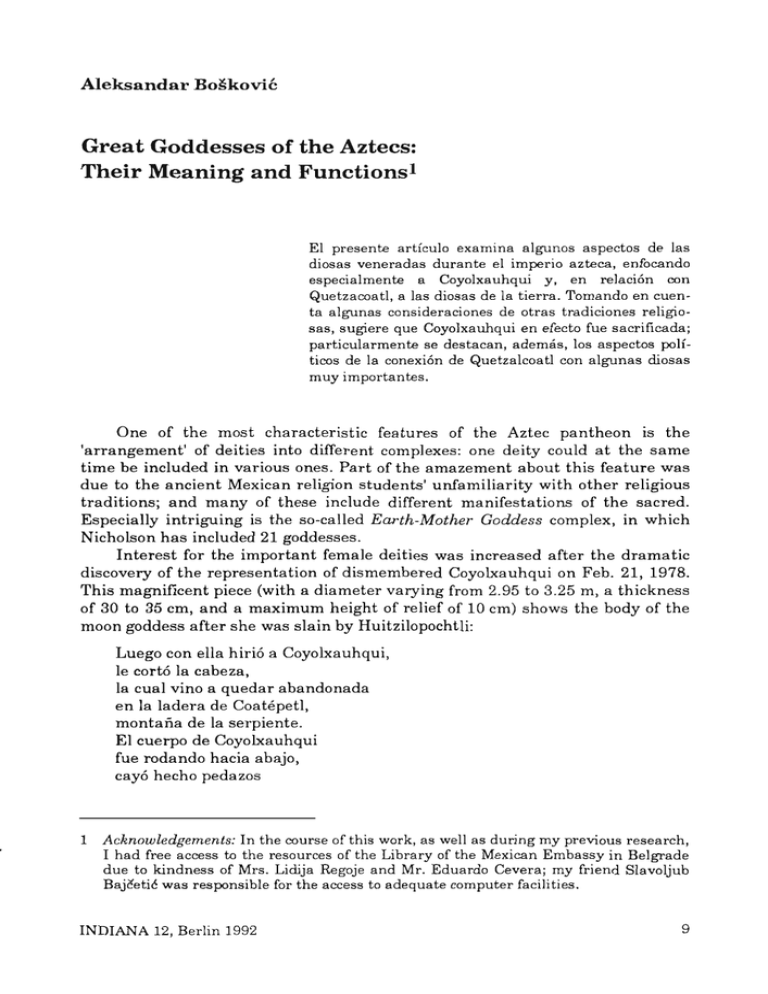
Aleksandar Boäkovic
Great Goddesses of the Aztecs:
Their Meaning and Functionsi
El presente artículo examina algunos aspectos de las
diosas veneradas durante el imperio azteca, enfocando
especialmente a Coyolxauhqui y, en relación con
Quetzacoatl, a las diosas de la tierra. Tomando en cuenta algunas consideraciones de otras tradiciones religiosas, sugiere que Coyolxauhqui en efecto fue sacrificada;
particularmente se destacan, además, los aspectos políticos de la conexión de Quetzalcoatl con algunas diosas
muy importantes.
One of the most characteristic features of the Aztec pantheon is the
'arrangement' of deities into different complexes: one deity could at the same
time be included in various ones. Part of the amazement about this feature was
due to the ancient Mexican religion students' unfamiliarity with other religious
traditions; and many of these include different manifestations of the sacred.
Especially intriguing is the so-called Earth-Mother Goddess complex, in which
Nicholson has included 21 goddesses.
Interest for the important female deities was increased after the dramatic
discovery of the representation of dismembered Coyolxauhqui on Feb. 21, 1978.
This magnificent piece (with a diameter varying from 2.95 to 3.25 m, a thickness
of 30 to 35 cm, and a maximum height of relief of 10 cm) shows the body of the
moon goddess after she was slain by Huitzilopochtli:
Luego con ella hirió a Coyolxauhqui,
le cortó la cabeza,
la cual vino a quedar abandonada
en la ladera de Coatépetl,
montaña de la serpiente.
El cuerpo de Coyolxauhqui
fue rodando hacia abajo,
cayó hecho pedazos
Acknowledgements: In the course of this work, as well as during my previous research,
I had free access to the resources of the Library of the Mexican Embassy in Belgrade
due to kindness of Mrs. Lidija Regoje and Mr. Eduardo Cevera; my friend Slavoljub
Bajáetió was responsible for the access to adequate computer facilities.
INDIANA 12, Berlin 1992
por diversas partes cayeron sus manos,
sus piernas, su cuerpo.
{Códice Florentino, Lib. III, Cap. I, León-Portilla 1963; reprinted in
Matos and Ehrenberg 1979: 6)
Dismembering of the deities is present in many traditions; it may have
cosmological (Ymir in Nordic mythology; Purusa in Hindu) or ritual function
(Sati in Hindu mythology; Osiris in Egyptian) - but it is not clear how we should
interpret the slaying of this goddess. Different functions have been suggested,
but also different 'readings' of the myth: while some authors (León-Portilla 1987;
Hultkrantz 1979) suggest that she was slain accidentally (i.e., she was heading
to warn Huitzilopochtli), others (Carrasco in ER 5) 'read' the event as it was
written down, presenting her as an inspirer and leader of 400 southerners. Cosmological interpretation has been suggested on account of her transformation
into the moon, and her brothers' into the Pleiades, especially considering Huitzilopochtli as a sun god (cf. Soustelle 1940: 8-9). But this slaying might have
had a purely ritual function: a two-headed serpent around Coyolxauhqui's waist
is tied into a knot; there are also serpents tied in this way around her arms and
legs, and we know from other Mesoamerican traditions that knots were used as
'marks' of the sacrificial victims. Is it possible that the great Méxica Aztec warrior god did not kill, but sacrificed his sister?^
Other deities that belong to this complex and that were venerated in the
time of Aztec supremacy also give rise to some interesting questions regarding
their interpretation. Ochpaniztli was the Aztec month in which ceremonies were
held in honor of four aspects of the Great Gk)ddess: Cihuateotl ('the Gk»ddess'),
Atlantonan ('Our Mother of Atlan'), Chicomecoatl ('Seven Snake'), and Toci
('Gra ndmother').
The first was the latrian form of that bevy of sinister female spirits
called the 'goddesses' (Cihuateteo). The second was Magna Mother as
she patronized certain diseases and maimings and who was additionally connected with water. The third was the Aztec Ceres, the provider
of fruits and grains from the earth, particularly maize. The last was a
grandly inclusive goddess, the mother of gods, a war goddess, a corn
goddess, maker of earthquakes, and patroness of sweatbaths and curing (Brundage 1985: 51).
Rituals connected with this month have already been described in full detail, and I do not intend to repeat these descriptions. However, it should be noted that all activities were divided according to the goddesses' specific functions.
I am not suggesting that we should deliberately use data from various Mesoamerican
cultures and insert them wherever it suits us (and it seems that this is the way in
which many authors regard the so-called 'direct historical approach'), but in this case
the figure itself requires a little bit broader context of possible explanation. For the
problems of interpretation, cf. Mates and Ehrenberg (1979: 70), for the interpretations
of Aztec sacrifice, I refer to Anawalt (1982).
10
For example, the ixiptia of Toci (who was an 'import' deity, the Aztec version of
the great Huaxtec mother Tlazolteotl) was forced to spin cotton - and spinning
and weaving are important attributes of the moon goddesses in the variety of
traditions (in fact, Tlazolteotl was the moon goddess). Among the 'warrior
aspects', the most famous representation is the 2.57 m high sculpture of Coatlicue ('Serpent skirt') at the Mexican Museo Nacional de Antropología: the bare
breasted mother of gods all arrayed with snakes, severed serpent heads, human
hands and hearts, skulls ... Her hands and feet end in claws because she feeds
on corpses. Thus she is "diosa de la tierra, del nacimiento y de la vejez, misterio
del origen y del fin, antigüedad y feminidad" (Justino Fernández in León-Portilla
1971: 575). While we have no information on who might have been the father of
Coyolxauhqui and her 400 brothers, Huitzilopochtli was conceived in a miraculous way: while Coatlicue was sweeping on the sacred mountain Coatepec, a ball
of feathers fell from the sky. She pressed it to her breast and immediately became pregnant.
This strange event resembles the Feathered Serpent or Quetzalcoatl, great
Toltec deity and ancestor of their ruling dynasty. According to the hymn that
was sung during the Aztec festival Atamalcualiztli (Brundage 1985: 32 ff.),
Quetzalcoatl in his fierce aspect as dog-headed Xolotl, carries the corn goddess
Xochiquetzal into the underworld and rapes her, after which she gives birth to
the young maize god Cinteotl. Another myth (León-Portilla 1971: 475 ff.)^
speaks of Quetzalcoatl's descent into the underworld for bringing the ancestors'
bones which will be melted by the earth goddess Cihuateotl ('Snake Woman')
and sprinkled with blood from Quetzalcoatl's penis, thus making the alloy for
the creation of mankind. There is also a legend of Quetzalcoatl (as a ruler of
Tollan) as son of the hunting god Mixcoatl ('Cloud Snake') and yet another earth
goddess, Chimalma.
It is obvious from all this that the relationships of this god with the vast
number of earth goddesses are extremely complex. It seems that in the period
preceding the Conquest these goddesses were responsible for certain
'amalgamatic' concepts that were supposed to unite different beliefs belonging to
different traditions. Teotihuacán Feathered Serpent, Toltec Topiltzin Quetzalcoatl, and Aztec Quetzalcoatl are not the same god, though all may have some
common traits. But for the Aztec priests it was necessary to legitimate their
i)eople as the logical successor and inheritor of the former cultures. The ball of
feathers falling from the sky and impregnating Coatlicue was just one of the
ways fulfill this task.
Finally, a note should be added about the principle of duality that was so
characteristic for the Mexican religion, briefly expressed in the following lines
from vol. VIII, fol. 175 of the Textos de Informantes Indígenas (León-Portilla
1971: 485):
Y sabían los toltecas
que muchos son los cielos.
3
In the variant of this myth in Thompson (1933: 162) this is Xolotl's task.
11
decían que son doce divisiones superpuestas.
Allá vive el verdadero dios y su comparte.
El dios celestial se llama Señor de la dualidad, Ometecuhtli,
y su comparte se llama Señora de la dualidad, Omecíhuatl, Señora celeste;
quiere decir:
sobre los doce cielos es rey, es señor.
This dual deity was also known as Ometeotl, which David Carrasco (DR:
241) considers as "the fundamental divine power in central Mesoamerican religion". The male 'part' of this Supreme God was identified with the sun, the female one with the earth. As Tonacatecuhtli and Tonacacihuatl they were regarded, respectively, as 'Lord' and 'Lady of Our Flesh'. There has been a lot of dispute about the actual antiquity of this concept, since it is exclusively found in
Postclassic cultures'*, but it seems that it has grown out from the need to systematize the 'state cults'®.
Abbreviations
DdR:
DictionncUre des religions. Sous le direction de Paul Poupard.
Paris: Presses Universitaires de France, 1984 [2nd edition:
1985].
DR:
Dictionary of Religions. Edited by John R. Hinnels. Harmondsworth: Penguin, 1984.
ER:
The Encyclopedia of Religion. 16 Vols. Editor-in-chief: Mircea
Eliade. London/New York: Macmillan, 1987.
References
Anawalt, Patricia R. (1982):
"Understanding Aztec Human Sacrifice." In Archaeology, 35.5: 38-45, New
York.
Bonifaz Ñuño, Rubén (1981):
The Art of the Great Temple, México-Tenochtitlan. Translated by W. Yeo-
4
Although Soustelle (DdR: 1243) considers this concept to be much older among the
Otomi, where it is represented by Otontecuhtli and Tzináná.
5
Or, as summed by Davies (1983: 221), the 'religion of the priests'.
12
mans. México: Instituto Nacional de Antropología e Historia/Secretaria de
Educación Pública.
Brundage, Burr Cartwright (1985):
The Jade Steps: A Ritual Life of the Aztecs. Salt Lake City: University of
Utah Press.
Carrasco, David (1987):
"Aztec Religion." In ER, 2: 23-29.
"Coatlicue." In ER, 3: 551.
"Human Sacrifice: Aztec Rites." In ER, 6: 518-523.
Davies, Nigel (1983):
The Ancient Kingdoms of Mexico. Harmondsworth: Penguin. [3*^ edition:
1985].
Hultkrantz, Äke (1979):
The Religions of the American Indians. Translated by Monica Setterwall.
Berkeley and Los Angeles: University of California Press [paperback edition:
1980].
León-Portilla, Miguel (1963):
"Mito del nacimiento de Huitzilopochtli." [Translation; in:] Justino Fernández: "Aproximación a Coyolxauhqui". In Estudios de Cultura Náhuatl, 4:
37-54, México.
León-Portilla, Miguel (1971):
De Teotihuacán a los aztecas: Antología de fuentes e interpretaciones históricas. México: Instituto de Investigaciones Históricas [S'^ edition: 1977].
León-Portilla, Miguel (1980):
Toltecayotl: Aspectos de la cultura náhuatl. México: Fondo de Cultura Económica
León-Portilla, Miguel (1987):
"Mesoamerican Religions: Pre-Columbian Religions." In ER, 9: 392-406.
Matos, Eduardo/Felipe Ehrenberg (1979):
Coyolxauhqui. México: Secretaría de Educación Pública.
Nicholson, Henry B. (1971):
"The Religion in Pre-Hispanic Central Mexico." In: Gtordon F. Ekholm/Ignacio
Bernal (Eds.): Archaeology of Northern Mesoamerica, Part I; Handbook of
Middle American Indians, pp. 395-446, Austin: University of Texas Press.
Soustelle, Jaques (1940):
La pénsee cosmologique des anciens Mexicains: Représentations du monde et
de l'espace. Paris: Hermann & Cie.
Thompson, J. Eric S. (1933):
Mexico Before Cortez: An Account on the Daily Life, Religion, and Ritual of
the Aztec and Kindred Peoples. New York: Charles Scribner's Sons.
13
